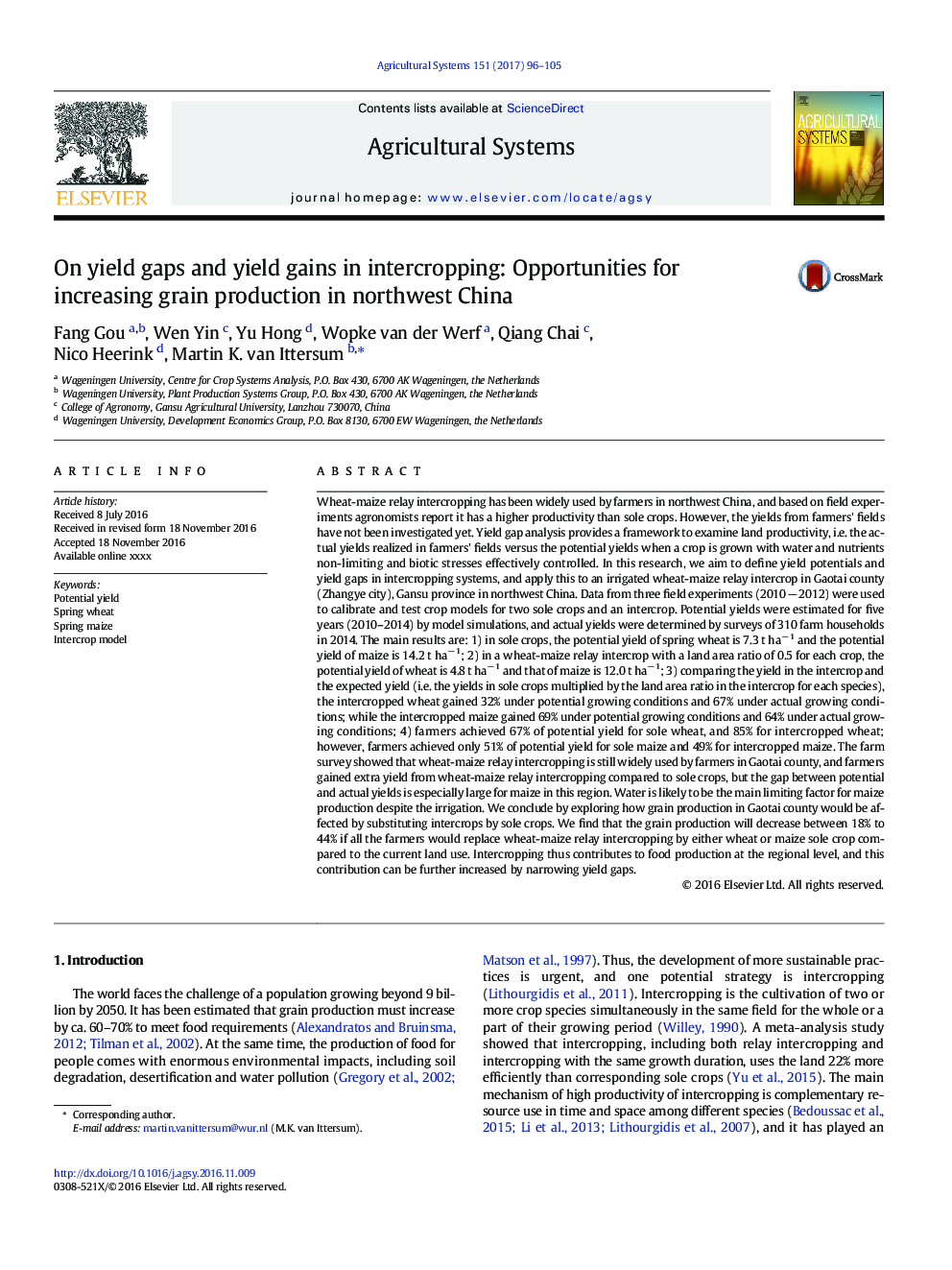| کد مقاله | کد نشریه | سال انتشار | مقاله انگلیسی | نسخه تمام متن |
|---|---|---|---|---|
| 5759783 | 1623219 | 2017 | 10 صفحه PDF | دانلود رایگان |
عنوان انگلیسی مقاله ISI
On yield gaps and yield gains in intercropping: Opportunities for increasing grain production in northwest China
ترجمه فارسی عنوان
شکاف عملکرد و سود حاصل از کشت مخلوط: فرصت برای افزایش تولید دانه در شمال غربی چین
دانلود مقاله + سفارش ترجمه
دانلود مقاله ISI انگلیسی
رایگان برای ایرانیان
کلمات کلیدی
عملکرد بالقوه، گندم بهار، ذرت بهار، مدل میانبره،
موضوعات مرتبط
علوم زیستی و بیوفناوری
علوم کشاورزی و بیولوژیک
علوم کشاورزی و بیولوژیک (عمومی)
چکیده انگلیسی
Wheat-maize relay intercropping has been widely used by farmers in northwest China, and based on field experiments agronomists report it has a higher productivity than sole crops. However, the yields from farmers' fields have not been investigated yet. Yield gap analysis provides a framework to examine land productivity, i.e. the actual yields realized in farmers' fields versus the potential yields when a crop is grown with water and nutrients non-limiting and biotic stresses effectively controlled. In this research, we aim to define yield potentials and yield gaps in intercropping systems, and apply this to an irrigated wheat-maize relay intercrop in Gaotai county (Zhangye city), Gansu province in northwest China. Data from three field experiments (2010 â 2012) were used to calibrate and test crop models for two sole crops and an intercrop. Potential yields were estimated for five years (2010-2014) by model simulations, and actual yields were determined by surveys of 310 farm households in 2014. The main results are: 1) in sole crops, the potential yield of spring wheat is 7.3 t haâ 1 and the potential yield of maize is 14.2 t haâ 1; 2) in a wheat-maize relay intercrop with a land area ratio of 0.5 for each crop, the potential yield of wheat is 4.8 t haâ 1 and that of maize is 12.0 t haâ 1; 3) comparing the yield in the intercrop and the expected yield (i.e. the yields in sole crops multiplied by the land area ratio in the intercrop for each species), the intercropped wheat gained 32% under potential growing conditions and 67% under actual growing conditions; while the intercropped maize gained 69% under potential growing conditions and 64% under actual growing conditions; 4) farmers achieved 67% of potential yield for sole wheat, and 85% for intercropped wheat; however, farmers achieved only 51% of potential yield for sole maize and 49% for intercropped maize. The farm survey showed that wheat-maize relay intercropping is still widely used by farmers in Gaotai county, and farmers gained extra yield from wheat-maize relay intercropping compared to sole crops, but the gap between potential and actual yields is especially large for maize in this region. Water is likely to be the main limiting factor for maize production despite the irrigation. We conclude by exploring how grain production in Gaotai county would be affected by substituting intercrops by sole crops. We find that the grain production will decrease between 18% to 44% if all the farmers would replace wheat-maize relay intercropping by either wheat or maize sole crop compared to the current land use. Intercropping thus contributes to food production at the regional level, and this contribution can be further increased by narrowing yield gaps.
ناشر
Database: Elsevier - ScienceDirect (ساینس دایرکت)
Journal: Agricultural Systems - Volume 151, February 2017, Pages 96-105
Journal: Agricultural Systems - Volume 151, February 2017, Pages 96-105
نویسندگان
Fang Gou, Wen Yin, Yu Hong, Wopke van der Werf, Qiang Chai, Nico Heerink, Martin K. van Ittersum,
